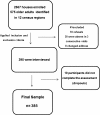Gait speed correlates in a multiracial population of community-dwelling older adults living in Brazil: a cross-sectional population-based study
- PMID: 23448191
- PMCID: PMC3598989
- DOI: 10.1186/1471-2458-13-182
Gait speed correlates in a multiracial population of community-dwelling older adults living in Brazil: a cross-sectional population-based study
Abstract
Background: Gait speed is a strong predictor of a wide range of adverse health outcomes in older adults. Mean values for gait speed in community-dwelling older adults vary substantially depending on population characteristics, suggesting that social, biological, or health factors might explain why certain groups tend to self-select their gait speed in different patterns. The vast majority of studies reported in the literature present data from North American and European populations. There are few population-based studies from other regions with a different ethnicity and/or social and health conditions. To address this, the present study identified the mean usual and fast gait speeds in a representative multiracial population of community-dwelling older adults living in a developing country, and explored their association with sociodemographic, mental and physical health characteristics.
Methods: This was a cross-sectional population-based study of a sample of 137 men and 248 women, aged 65 years and over. Usual gait speed and fast gait speed were measured on a 4.6 m path. Participants were classified into slow, intermediate, and faster groups by cluster analysis. Logistic regression analysis was used to estimate the independent effect of each factor on the odds of presenting with a slower usual and slower fast gait speeds.
Results: Participants had a mean (SD) usual gait speed of 1.11 (0.27) m/s and a mean fast gait speed of 1.39 (0.34) m/s. We did not observe an independent association between gait speed and race/ethnicity, educational level, or income. The main contributors to present a slower usual gait speed were low physical activity level, stroke, diabetes, urinary incontinence, high concern about falling, and old age. A slower fast gait speed was associated with old age, low physical activity, urinary incontinence and high concern about falling.
Conclusion: A multiracial population of older adults living in a developing country showed a similar mean gait speed to that observed in previously studied populations. The results suggest that low physical activity, urinary incontinence and high concern about falling should not be neglected and may help identify those who might benefit from early intervention.
Similar articles
-
Factors associated with lower gait speed among the elderly living in a developing country: a cross-sectional population-based study.BMC Geriatr. 2015 Apr 1;15:35. doi: 10.1186/s12877-015-0031-2. BMC Geriatr. 2015. PMID: 25880124 Free PMC article.
-
Associations between gait speed and well-known fall risk factors among community-dwelling older adults.Physiother Res Int. 2019 Jan;24(1):e1743. doi: 10.1002/pri.1743. Epub 2018 Sep 10. Physiother Res Int. 2019. PMID: 30198603
-
The association between fear of falling and smoothness of lower trunk oscillation in gait varies according to gait speed in community-dwelling older adults.J Neuroeng Rehabil. 2017 Jan 19;14(1):5. doi: 10.1186/s12984-016-0211-0. J Neuroeng Rehabil. 2017. PMID: 28103907 Free PMC article.
-
The impact of testing protocol on recorded gait speed.Gait Posture. 2015 Jan;41(1):329-31. doi: 10.1016/j.gaitpost.2014.10.020. Epub 2014 Oct 28. Gait Posture. 2015. PMID: 25468684 Free PMC article.
-
Measurement properties of the usual and fast gait speed tests in community-dwelling older adults: a COSMIN-based systematic review.Age Ageing. 2024 Mar 1;53(3):afae055. doi: 10.1093/ageing/afae055. Age Ageing. 2024. PMID: 38517125 Free PMC article.
Cited by
-
Reduced flexibility associated with metabolic syndrome in community-dwelling elders.PLoS One. 2015 Jan 23;10(1):e0117167. doi: 10.1371/journal.pone.0117167. eCollection 2015. PLoS One. 2015. PMID: 25614984 Free PMC article.
-
Factors associated with lower gait speed among the elderly living in a developing country: a cross-sectional population-based study.BMC Geriatr. 2015 Apr 1;15:35. doi: 10.1186/s12877-015-0031-2. BMC Geriatr. 2015. PMID: 25880124 Free PMC article.
-
Spatiotemporal and variability gait data in community-dwelling elderly women from Brazil.Braz J Phys Ther. 2016 Mar 22;20(3):258-66. doi: 10.1590/bjpt-rbf.2014.0157. Braz J Phys Ther. 2016. PMID: 27437717 Free PMC article.
-
Physical reserve: construct development and predictive utility.Aging Clin Exp Res. 2023 May;35(5):1055-1062. doi: 10.1007/s40520-023-02371-5. Epub 2023 Feb 27. Aging Clin Exp Res. 2023. PMID: 36848030
-
Correlates of Gait Speed Among Older Adults From 6 Countries: Findings From the COSMIC Collaboration.J Gerontol A Biol Sci Med Sci. 2023 Dec 1;78(12):2396-2406. doi: 10.1093/gerona/glad090. J Gerontol A Biol Sci Med Sci. 2023. PMID: 36975099 Free PMC article.
References
-
- Abellan Van Kan G, Rolland Y, Andrieu S, Bauer J, Beauchet O, Bonnefoy M, Cesari M, Donini LM, Gillette Guyonnet S, Inzitari M. Gait speed at usual pace as a predictor of adverse outcomes in community-dwelling older people an International Academy on Nutrition and Aging (IANA) Task Force. J Nutr Health Aging. 2009;13(10):881–889. doi: 10.1007/s12603-009-0246-z. - DOI - PubMed
-
- Cesari M, Kritchevsky SB, Newman AB, Simonsick EM, Harris TB, Penninx BW, Brach JS, Tylavsky FA, Satterfield S, Bauer DC. Added value of physical performance measures in predicting adverse health-related events: results from the Health, Aging And Body Composition Study. J Am Geriatr Soc. 2009;57(2):251–259. doi: 10.1111/j.1532-5415.2008.02126.x. - DOI - PMC - PubMed
Publication types
MeSH terms
LinkOut - more resources
Full Text Sources
Other Literature Sources
Medical


